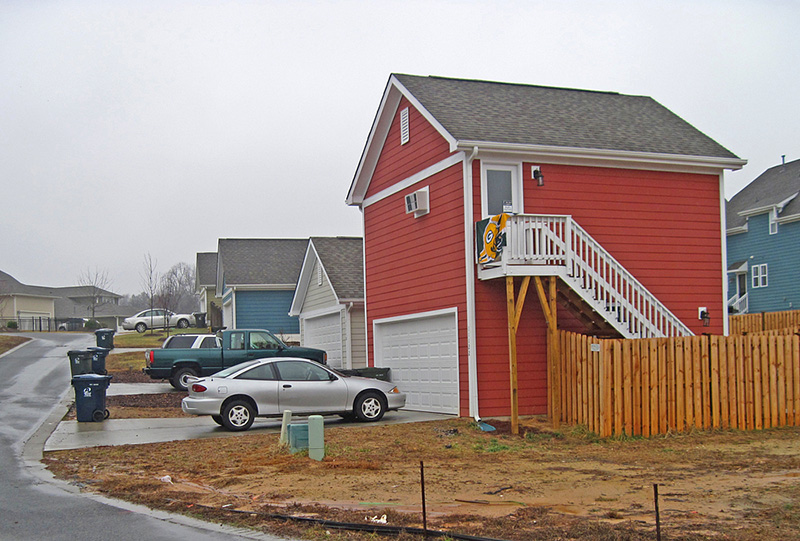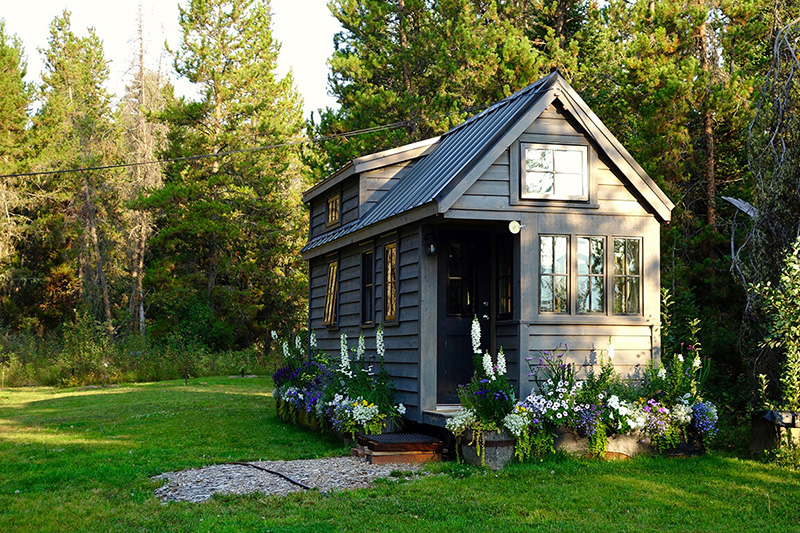Accessory Dwelling Units – Part of the Housing Crisis Solution?
| . Posted in News - 4 Comments
By Eric Weld, MassLandlords, Inc.
Accessory Dwelling Units (ADUs) may have become easier to develop and build in Massachusetts, thanks to zoning change regulations passed as part of the state’s housing choice legislation in January 2021. With the law’s statewide change to a lower voting threshold required to amend some local zoning ordinances, municipalities may now be able to pass ADU-friendly zoning that they couldn’t have managed before.

Accessory dwelling units come in many shapes, sizes and configurations, such as this detached over-the-garage apartment. (Image: cc by-sa Wikimedia commons)
More ADUs could have an important positive impact on the state’s affordable housing stock over time. So far, however, there is little evidence of a rush to pass zoning changes that could ease the ADU building process.
Every one of the 350 towns and cities under the auspices of the state’s Zoning Act has its own local zoning ordinances. And while a few communities, such as Salem and Arlington, are pushing forward with ADU zoning changes, several fronts of resistance to this once-popular housing option remain.
What Are ADUs?
Accessory dwelling units, also commonly referred to as in-law apartments, add-on apartments, mother-in-law apartments, “granny flats” and other terms, are smaller, separate dwellings on a property with a larger dwelling. ADUs have their own dedicated entrances, and their own kitchens and bathrooms. Most often, these dwellings have one bedroom, but some have a studio-style layout, and a small percentage may have two bedrooms or more. According to the housing choice law, Chapter 358 of the Acts of 2020, ADUs must be restricted in size to either no more than half of the principal dwelling on the property or 900 square feet, whichever is smaller. Further size restrictions and other regulations may be imposed by specific municipal ordinances. ADUs can be attached to the main house, such as an attic or basement apartment, or may be detached, as an apartment over a garage, for example, or a converted carriage or pool house.
In the right circumstances, ADUs can allow homeowners to provide a living space for an aging relative or a child in college. It can also provide additional income for homeowners who might rent out their ADU.
ADUs can be a solution for renters seeking affordable housing. Because the square footage of ADUs is small, rent for such units is usually relatively low. And ADUs often make for desirable living spaces because the landlord is on the premises and is therefore more likely to tend to maintenance, upkeep and aesthetics, and to keep noise to a minimum.

ADUs such as this tiny house at the back of a residential lot could add to the state’s affordable housing stock and help provide a solution to housing crises. (Image: cc sa-by pinterest.)
ADU Advantages Over Multi-families
Accessory dwelling units can be a highly advantageous option for providing housing in contrast with other housing formats, such as duplexes, triplexes and multi-unit buildings. For one thing, the addition of an ADU to a single-family property can usually be managed relatively cheaply – $50,000 or less – and paid for by the property owner. Often these units can be built without the need of an architect or developer, and are sometimes even built or renovated by the homeowners themselves. In some cases, ADUs can be built as of right, without the requirement of special permits.
ADUs are typically small and therefore require only a modest addition to the building footprint. Sometimes, as in the case of renovated basement, attic or over-the-garage apartments, they don’t add any square footage to an existing structure. ADUs also usually house only one or two people, so the impact on utilities is minimal.
Absent single-family zoning restrictions, every homeowner across the state (or country, for that matter) would be free to add an ADU and house a renter in affordable fashion. There are millions of single-family homes in Massachusetts. If ADUs became a trend, it would make a substantial impact on alleviating the housing shortage.
A Popular Housing Option Once Upon a Time
There once was a time when ADUs were a popular housing option in the United States. For centuries, it was common for property owners to add over-the-garage and basement apartments or build carriage and gate houses. Often homeowners would build a small dwelling on a new property, then add a main house as the family grew. ADUs frequently provided space for aging relatives to remain living with their families.
In the years after World War II, ADUs gradually fell out of favor as rapidly expanded suburbanization and an accompanying growth in preferences for larger lot sizes and lower density triggered zoning laws reflecting these trends. ADUs decreased precipitously as single-family zoning proliferated and lots occupied by one home with a yard became the American ideal.
While ADUs have begun trickling back into communities in recent decades, the single-family-only home trend has dominated to the present. Partly as a result, house and lot sizes have expanded and cities have sprawled, driving up home prices, crowding out room for affordable housing and suppressing alternative options like multi-families and ADUs.
An American ADU Comeback?
Circumstances may be about to change. As the nation finds itself in a housing hole with home prices shooting skyward and sorely lacking enough affordable housing, some states are moving to address the inequities legislatively. Among these states’ strategies is easing legal obstacles to building ADUs.
California, which has a well-reported housing and homeless crisis, is among the most aggressive. A slew of state bills passed in 2020 and 2021 removed several longstanding restrictions to building ADUs, including the owner-occupancy requirement, which mandates that the owner live on the property in order to add an ADU. The largest state also removed municipal requirements that properties with ADUs have a minimum square footage, eased setback requirements so that more building space is available for additions, removed restrictions on converting storage spaces into ADUs and reduced parking space requirements. California has also created earmarked funds for incentivizing ADU construction, lowered fees and sped up permitting timelines, among other measures.
New Hampshire passed a law in 2017 that cleared obstacles to ADUs, including a requirement that local zoning ordinances allow ADUs on single-family properties. The state also removed the maximum size limit of 750 square feet for ADUs, the owner-occupancy requirement and other mandates. Oregon also enacted recent legislation facilitating ADU construction.
For its part, Massachusetts ratified the Housing Choice Law, Chapter 358 of the Acts of 2020, as part of Gov. Charlie Baker’s $626 million economic development bill, signed on Jan. 14, 2021. The law includes a series of revisions to the 1954 Zoning Act. One of those revisions lowered the voting threshold for making some local zoning ordinance changes from a supermajority (two-thirds vote required) to a simple majority, in which zoning changes require more than 50% of a municipality’s legislative body to vote in favor.
This change alone should make it easier for communities throughout the state to ratify zoning ordinances that favor multifamily housing, including ADUs.
ADUs Zoning Changes in Salem and Arlington
Two Massachusetts communities that have been attempting to ease the process for building ADUs may be helped by the voting threshold change in the Housing Choice Law.
Salem Mayor Kim Driscoll had made several attempts at changing the coastal city’s zoning ordinances to ease the process for building ADUs and allowing property owners with existing ADUs to rent them out to unrelated tenants. The proposal to the Salem City Council had failed on two occasions by a vote of seven in favor, four opposed, due to lack of a supermajority in favor. Now, with the simple majority threshold in place, the proposal passed with an identical 7–4 City Council vote in May.
In Arlington, Town Meeting has similarly failed to reach the two-thirds majority approval for a proposal to allow the building of ADUs by right. (That is, as long as a planned ADU addition meets all state building code provisions and dimensional regulations, it may be built without a special permit.) The town finally passed the zoning change with assistance from the state law voting threshold adjustment and awaits approval from the attorney general to enact the ordinance.
How Many Forms of Egress?
As more Massachusetts communities move toward considering zoning and law changes to accommodate ADUs, one point of confusion warrants mentioning. The state building code (780 CMR) requires that most residential dwellings have two means of egress, defined as unobstructed and constantly accessible exits to the exterior. That has traditionally been the operational protocol for constructing buildings in the state, with a few exceptions outlined in the code.
However, the new housing law, in defining “accessory dwelling unit” (Section 16), states that an ADU is a self-contained housing unit that “maintains a separate entrance, either directly from the outside or through an entry hall or corridor shared with the principal dwelling sufficient to meet the requirements of the state building code for safe egress.”
(The confusion was recently reflected in Salem Mayor Kimberly Driscoll’s draft of a proposal to change the city’s ADU egress requirements.)
It’s possible these two clauses correspond, if an ADU includes forms of egress other than an entrance. If in doubt, the longstanding building code should guide egress decisions in new ADU construction. (Readers with insight on questions of egress and the distinctions between requirements for one or two means of egress in dwellings are invited to provide clarity by emailing hello@masslandlords.net.)
Barriers to ADUs
Despite increasing evidence that ADUs are an additive in terms of expanding affordable housing, and that they provide a means for more sustainable development, towns and cities in Massachusetts have largely been slow to adopt policies easing their construction.
While Salem and Arlington work to change local ADU zoning ordinances, the majority of cities and towns in the Greater Boston region restrict development of ADUs. A review by the Pioneer Institute on Public Policy of 100 cities and towns around (but not including) Boston found that, among the 37 communities that allow ADUs, only 2.5 are built per year.
Often, when ADU zoning comes before local legislative boards, a culture of NIMBY (or, if you prefer, the latest anti-development acronym, BANANA: Build Absolutely Nothing Anywhere Near Anything) gums the passage of bylaws that could result in more ADU construction. Many neighbors fear increased density, meaning more foot traffic, noise and garbage near their homes (often their back yards).
Increased density also means more automobile traffic and parked cars. Some residents resist the prospect of introducing more cars into neighborhoods in which curbside parking spaces are a rare and valuable commodity as it is. An emphasis on bike-riding and public transportation could alleviate these concerns, but most suburban areas are over-reliant on cars and not adequately equipped with bike lanes and access to public transportation.
Neighborhood Character and Property Values
Residents are also concerned about the impact on schools and neighborhood “character” that they think ADUs and increased density would levy.
And a prominent fear, which lacks evidence, is that ADUs will have a negative impact on property values in the region by changing neighborhood appearance from a single-family, suburban mien to a more urban, denser aspect.
There is no evidence that ADUs bring down property values in neighborhoods, mostly because there is almost no research on the subject. In fact, limited evidence shows that adding an ADU to a property typically increases the value by as much as 25% to 34%.
The Pioneer Institute study goes as far as to contend that “the development of more accessory dwelling units would help ease the [Boston] region’s housing shortage without creating any significant problems.”
The Upsides of ADUs
The need for new housing, especially affordable housing, is clear in Massachusetts and many other states. But building apartment complexes, or even duplexes and triplexes, usually requires willing investors and developers who can afford the land and building costs, plus necessary permits and fees. And while these dwelling types will remain part of the housing canon, they typically take longer to build and get online – more than a year – in contrast with ADUs.
Meanwhile, accessory dwelling units provide a low-cost, often self-funded investment opportunity for single-family property owners who may want to make some extra income and add an inexpensive rental to the market. And ADUs take a fraction of the time – 2-4 months – that it takes to build larger housing options.
Aside from inflated and imprecise NIMBY and BANANA objections, it’s hard to ignore the upsides of ADUs as a significant part of the solution to housing crises. The price of land and homes keeps increasing, as does the population of people without homes and those unable to afford suitable housing. At some point something will have to give.
Clearing out single-family zoning and giving property owners more freedom to provide housing, such as ADUs, on their own land could be a substantial part of the answer.




